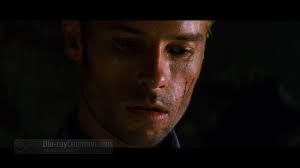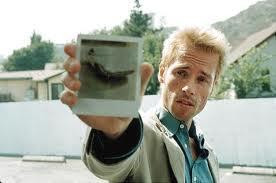In honor of the release of the new Superman movie, we’ve decided to examine all eight of Christopher Nolan’s films, from Following to The Dark Knight Rises. Each day, We Minored in Film’s own Julianne Ramsey will discuss and examine one of Nolan’s movies, leading up to the June 14th release of Man of Steel. Granted, Christopher Nolan only produced Man of Steel whereas Zack Snyder directed it (although Nolan was on set from time to time). However, Nolan’s influence on the film is still where the movie’s publicity emphasis has been placed. So, that’s where we went with it.
I am going to attempt to be as spoiler-free as possible, because I think Nolan’s films are best enjoyed without prior knowledge of the paths they take. Yet there may be times in which I want to talk about a certain twist or plot development, and I will do so. What that basically boils down to is: Be warned. Spoilers may be present, but they will be minimal.
Film: Memento (2000)

If Following indicated Christopher Nolan had the potential to be a competent director, his next film announced to anyone taking notice that a major, new talent had arrived on the scene. Memento presents the story of Leonard Shelby, a man looking for his wife’s killer. The problem? The night his wife was murdered, he suffered a head injury that resulted in anterograde memory loss. He hasn’t been able to make new memories since that night. In order to survive, he tattoos his body with important details and takes Polaroids of everything/ everyone he encounters.

“Pick up dry cleaning, buy milk, take kids to soccer…” Oh, wait. Actually, it’s a bit darker than that.
The film opens with Leonard finding the man his notes tell him is his wife’s killer and taking his revenge. It’s plot unfolds in two, separate strains that intersect at the film’s conclusion: a black-and-white plot progressing forward and one in color regressing backward. The viewer sees the colorized scenes without knowing what has come before them, just like Leonard Shelby.
I love this film, and there is already evidence of that in my previous article about a single scene from the film which I adore. I’ve seen Memento probably fifty times, and it holds up beautifully. Nolan took the lessons and techniques he attempted in Following and utilized them to perfection. Leonard, unable to process/ move forward from his wife’s death because he cannot feel time passing/ remember any emotional growth he has made since her death, feels her loss as freshly as though it had only happened the day before.
Check out this scene where he discusses his problem with adjusting to her loss:
As it is, the viewer has no idea how long she has been gone and Leonard does not either. He could have been looking for his wife’s killer for a week or a year. He is the epitome of an unreliable narrator.

“What I was gonna say was…oh, man. I just had it.”
Leonard’s emotional grief and fractured memory place him in a position to be manipulated by opportunistic parties, and the film gives us two suspicious side characters whose motives for assisting Leonard become both clearer and murkier with each passing scene: the overly-friendly Teddy and the grieving, possibly sinister, femme-fatale Natalie. Both are introduced as aides in his vengeance quest, but we know Leonard kills Teddy in the opening scene, believing him to be his wife’s killer. Why has Leonard written, “don’t believe his lies” on Teddy’s Polaroid, and what was crossed out on Natalie’s photo? The viewer spends as much of the film in the dark as Leonard does.

The dawn of a new buddy cop series? Nope, buddy cops don’t kill other buddy cops.
Like Following, once you put the film’s plot in linear order, it becomes clear that the storyline is not particularly complicated, but where Following’s jumbled narrative felt like an unnecessary distraction, Memento’s structure enhances the viewing experience. The viewer is elated and thrilled by the film’s confusing, out of order plot, desperate to keep up. It also conceals the fact that Leonard is probably not a central character to be trusted. After all, he only knows what is written down in his notes and on his photos. There’s a scene in which a character, seeking to manipulate him, comes into his/ her home and immediately hides all of his/ her pens. Without access to any writing utensil, he cannot remind himself of what has transpired and major character developments are soon forgotten. We see how easily he can be manipulated, but we still assume we are getting the most important aspects of the narrative. The viewer trusts his perceptions implicitly, because we are just as disoriented. We only know his perspective, and even though his perspective is fragmented and distorted, we have no choice but to accept his claims.
Nolan even provides us with a Leonard parallel: Sammy Jankis, the man who Leonard didn’t believe suffered from the condition now plaguing him. Sammy gave his wife too much diabetic insulin, because he didn’t remember he had given her any at all. He is the man in an institution Leonard could (has?) become if he is not careful.

“Have you seen my car? I forgot where I parked it.”
Nolan’s film not only makes begin to question everything Leonard has told us, but our own memories. When we see a scene, then see the scene that, chronologically, comes before it, we find ourselves struggling to remember the significant details we have just been shown. We begin to wonder about the reliability of our own memories. When Leonard talks about pretending to recognize someone because he thinks he is supposed to know who the person is, is it really that different from pretending to recognize someone who has stopped you on the street? Is our intact memory really remarkably better than Leonard’s shattered memory?
Memento is a brilliant, near-perfect film with a knock-out climax revelation, all going back to the “don’t believe his lies” Leonard inscribed on the back of Teddy’s polaroid- it’s basically the lie that rots Leonard’s quest from the inside-out and places him on a never-ending cycle he wouldn’t end, even if he could.
I remember seeing the movie in a theatre with about twenty other people. The movie concludes with Leonard stopping at a tattoo parlor (where we have already seen him getting a license plate number tattooed on his thigh), thinking the line, “Now, where was I.” I remember the audience starting to laugh at the line, then the laughter faded out as the audience remembered the journey Leonard was about to take (though for us, the journey had already been taken). He is a victim of manipulation and deceit, but in the end, the individual who most deceives Leonard is himself.
Check out a trailer below:
Memento is available to stream through Netflix and is available to purchase on DVD or Blu-ray.
So, what do you think? Are you a fan of Memento? Do you hate it? Let us know in the comments.
Next Up in The Great Christopher Nolan Film Re-Watch is Insomnia, in which Al Pacino rages against the non-dying light and Robin Williams officially puts Mrs. Doubtfire behind him (probably in a body bag).

